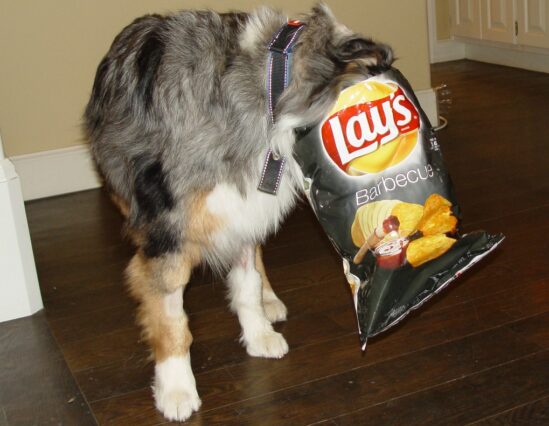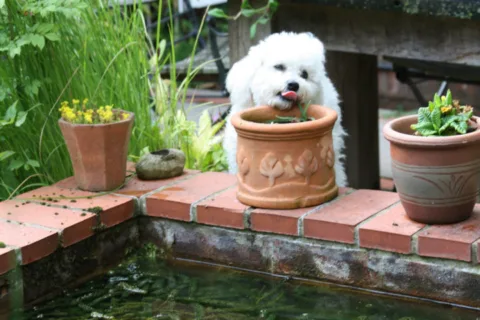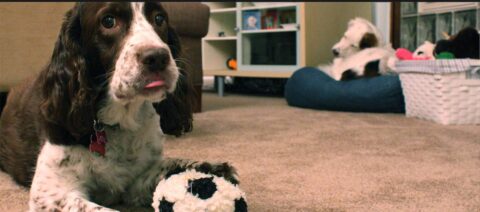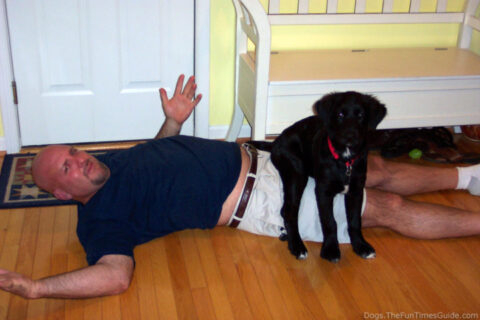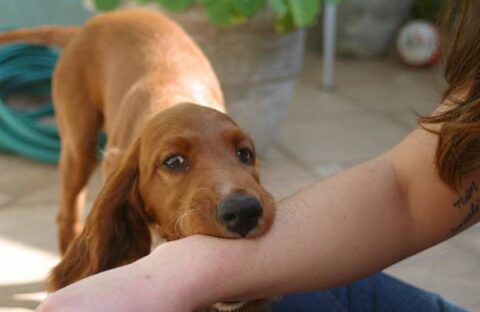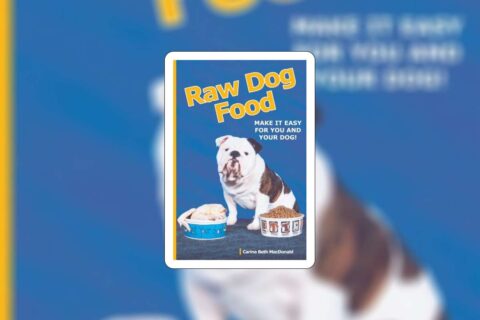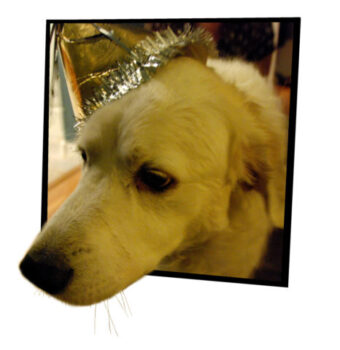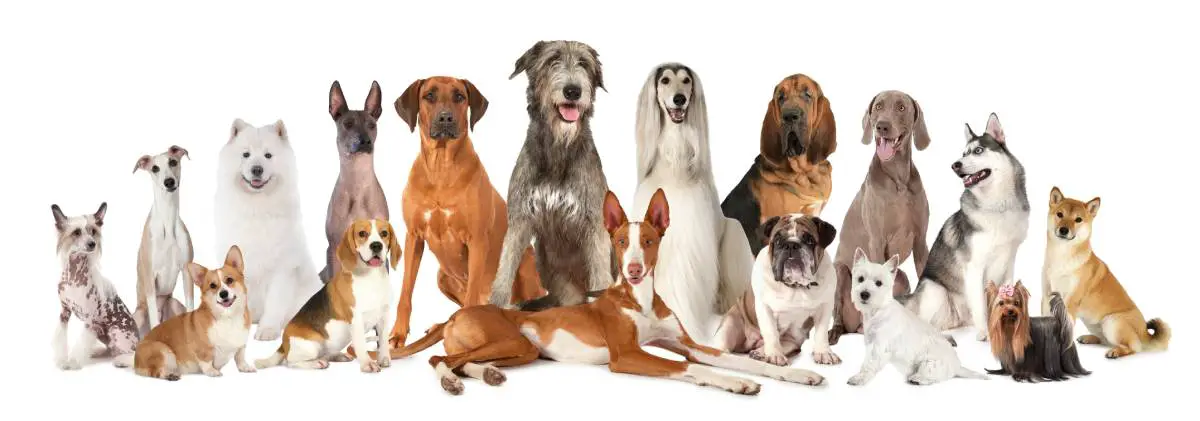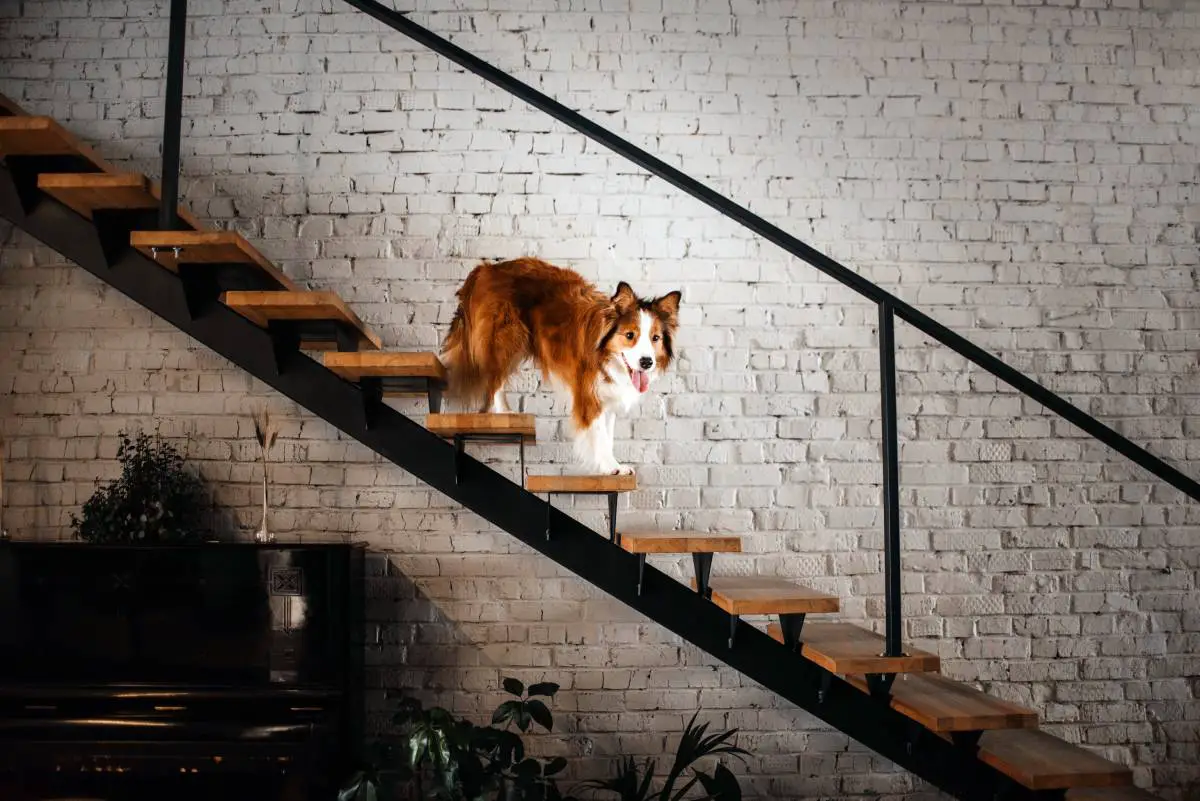Even if your dog doesn’t seem like the mischievous type that would be likely to get into stuff, it’s still important to take the time to puppy proof your house.
There are lots of ways that a dog can become seriously injured in your own home — most are ways that few people would even think about.
Safety First When It Comes To Your ‘Baby’
Puppy proofing your house requires basically the same steps as baby-proofing a home does. Most of the hazards and predicaments that babies and toddlers can get into — dogs can too. (Minus any that require opposable thumbs!)
And the age of your dog is irrelevant.
You should puppy proof your home whether your new dog is a rambunctious little puppy, a full-grown adult, or even a senior dog. If the house is new to them, then it needs to be dog proofed.
Don’t Wait… For Your Dog’s Sake
Unfortunately, sometimes weeks, months, or even years will go by before a new dog owner actually takes the time to look around the house and move (or remove) those items which could be a safety concern for dogs.
And sometimes it takes an unfortunate accident before a dog owner is motivated to puppy proof their home.
Hopefully, this article will be your motivation.
When You Have A Dog, Accidents Happen
You may be thinking:
- “My dog just doesn’t do that. He never has.”
- “If it hasn’t happened by now, then my dog just knows not to do that.”
Just know that it’s not a matter of your dog knowing right from wrong. Usually, it’s simply a matter of your dog being in the wrong place at the wrong time.
Accidents happen. (Trust me, I know.) And your dog could pay the ultimate price if you don’t take steps now to properly puppy proof your entire home. Right now.
So, whether you’re a new dog owner or you’ve had dogs for years but you just haven’t “officially” puppy-proofed your house yet, these tips could literally save your dog’s life!
Here’s how to do CPR on a dog.
Now, let’s talk about how to puppy proof your house…
How To Puppy Proof Your House
When you bring a dog home for the first time, it’s important that you take a look around your house and determine which things you need to move, or close, or place higher up on shelves, or hide behind doors.
You need to puppy proof your home now — because you’ve got tails & tongues to watch out for, and 4 playful paws can turn virtually anything into a toy!
Aside from the typical pet dangers that we dog owners hear so much about (like foods that are dangerous for dogs and backyard hazards for dogs), there are a number of other common household dangers that dog owners should also be aware of.
Some of these I’ve learned firsthand. Others I’ve witnessed while working at the vet, or read about from dog owners whose dogs were hurt or killed as a result of these common everyday household dangers.
Things To Move Or Keep Higher Up On Shelves
- Plants — some plants are poisonous to dogs.
- Candles — especially when lit, the flames can appear fun to play with to a dog. Don’t overlook the fact that your dog’s tail could easily brush past the flame of a candle, and set your dog… and your entire home on fire!
- Items on window sills — avoid leaving anything in the way of windows so your dog can look out & see what’s going on. Be sure to move them before he moves them for you! (Our floor lamp almost got broken this way.)
- Glass jars and bottles — remove them now so your dog can’t knock them off a counter, a ledge, or a table (maybe even with his tail).
- Prescription bottles & pill organizers — a dog can easily chew open a childproof container. A plastic pill bottle can be cracked open in no time by a dog that’s intrigued by what’s rattling inside. Human medications that are toxic to dogs include painkillers, cold medicines, vitamins, and diet pills, among others.
- Decorative items and knick-knacks — it’s all fair game once your dog starts to sniff around and explore. And you don’t want anything valuable broken (or knocked on the floor by your dog’s tail!) You could also use baby gates or other homemade barriers to separate your dog from your precious valuables.
- Hair dryers and curling irons — if you leave yours resting on the counter, your dog’s paws or tail could get tangled in the cords resulting in a burn or strangulation.
Mothballs, tobacco products, pennies (those minted after 1982 contain zinc), and alkaline batteries (like those in your remote controls) can also be hazardous when ingested. — American Veterinary Medical Association
- String, yarn, sewing thread, rubber bands, dental floss — if swallowed, “stringy” items such as these can cause intestinal blockage or even strangulation. Internally, strings (yes, even those chewed off a rope toy for dogs!) can tighten around themselves or other internal organs and cause serious damage.
- Electrical cords and phone chargers — wandering puppies can inadvertently find themselves tangled in one or more cords lying on the floor or hanging from a desk or table. A dog can suffer burns or electrocution from chewing on live cords. To prevent this, use cord covers and block access to all wires inside your home. The one and only item my puppy ever chewed on was a phone charger. Since then, we’ve tried to tame the cord clutter at work stations throughout the house and “hide” cords under baseboards & carpet seams whenever possible.
- Soaps and other personal care supplies — things like bath soap, and hand soap, toothpaste, and sunblock should all be kept away from your dog. They can cause stomach upset, vomiting or diarrhea if ingested. (FYI: You should only use dog friendly toothpaste, shampoo, and sunblock when grooming your dog.)
- Paper shredders — either keep your paper shredder up high on a desk or shelf, or keep it unplugged when not in use. This may seem like an inconvenience — but if your dog can walk past that shredder, then he can get his tongue or tail accidentally caught inside. Something as simple as a dog’s tail lightly brushing past the blades could activate the auto-ON mechanism. And, dogs like to lick things. One lick along the top of the shredder and…. well, you don’t want this to happen to your dog’s tongue!
Here’s a very graphic example of what can happen to a dog’s tongue when caught in the paper shredder.
Things To Keep Securely Closed
- Toilet seat lid — curious puppies (and thirsty ones too) can become fascinated by the water inside the toilet bowl, fall in, and drown. Odds are, you’ll forget and leave the toilet lid up more than once. For that reason, you should avoid using any sanitizing toilet products. (You know, the ones that make your water a pretty blue, or sparkling clear.) We keep the door to each of our bathrooms closed at all times.
- Garbage pails — your best bet is to get a dog proof trash can. If you don’t want to do that, then be sure to place all your trash cans behind cabinet doors OR use a very tall pail with a securely closing lid. Dogs are champs at finding ways to get at food scraps and garbage — whether it’s smelly or not.
- Windows and doors — a dog can slip out of an unlatched door or a loose window screen in a heartbeat!
Here are some other ways you’ll want to modify your window blinds, curtains and door latches when you have a dog in the house.
Things To Keep Behind Closed Doors
- Potato chips & other snack foods — before you had a dog, these might have normally been left on the counters, lower shelves, or other places around the house. Depending on the size of your dog (or his jumping abilities), these may not be safe places anymore.
- Leftover foods — especially poultry because chicken bones and turkey bones can wreak havoc on a dog.
- Cleaning products & chemicals — antifreeze and pesticides are a given because they’re talked about all the time. But don’t overlook the everyday products used to keep your house clean and fresh smelling!
Paint thinners, mineral spirits, and other solvents are dangerous and can cause severe irritation or chemical burns if swallowed or if they come in contact with your dog’s skin. While most latex house paints typically produce a minor stomach upset, some types of artist’s or other specialty paints may contain heavy metals or volatile substances that could become harmful if inhaled or ingested. — American Veterinary Medical Association
How To Puppy Proof Your House Room By Room
In addition to the links I’ve provided above, here are some additional resources that show how to puppy proof every single room inside house:
- Pet Hazards In Each Room Of Your Home
- Indoor & Outdoor Hazards For Dogs
- Pet Proofing Your Home
- How To Dog Proof Your House Room By Room
I like to help Dog Parents find unique ways to do things that will save time & money — so I write about “outside the box” Dog Tips and Dog Hacks that most wouldn’t think of. I’m a lifelong dog owner — currently have 2 mixed breed Golden Aussies that we found abandoned on the side of the road as puppies. I’ve always trained my own dogs and help friends train theirs, as well. Professionally, I worked at a vet and have several friends who are veterinarians — whom I consult with regularly. (And just because I love animals so much, I also worked at a Zoo for awhile!) I’ve been sharing my best ideas with others by blogging full-time since 1998 (the same year that Google started… and before the days of Facebook and YouTube). My daily motivation is to help first-time dog owners be better prepared from the first day your new puppy enters your home. I like to help dog owners understand what’s ‘normal’ and what you can expect in terms of living with and training your dog — how to get through the ups & downs of potty training, chewing, teaching commands, getting your dog to listen, and everything else that takes place during that hectic first year! When I’m not training, walking, grooming, or making homemade treats for my dogs, you will find me at the corner of Good News & Fun Times as publisher of The Fun Times Guide (32 fun & helpful websites). To date, I’ve written over 600 articles for dog owners on this site! Many of them have upwards of 200K shares.
